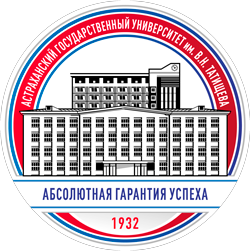External restrictions and challenges for ASU’s activity are: a) maintaining a low level of demand that can be paid by population for services; b) high competition in the market of innovative services; c) decreasing attractiveness of the teaching profession as well as the status of a young scientist for talented university graduates; d) the employers not ready to invest personnel training, professional development of specialists, improving the competencies of personnel and financing scientific research; e) insufficient number of high-tech industries in the region; f) increasing competition from leading universities and dumping prices from competitors in the regional market; g) the lack of the possibility to involve “world-class” scientists from other universities.
Internal restrictions for the university’s development are: a) the educational process aligned insufficiently with world science, high-tech production, developing business achievements; b) a short list of educational programs taught in foreign languages; c) decrease in the efficiency indicators of research activities: reduction of budget funding for research and development, low growth rates of Research, Development and Engineering volumes; d) inflexibility in the management of research activities, low level of commercialization; e) low publication activity of the university’s practices and scientific developments; f) lack of Dissertation Board; g) insufficient development of the digital scientific and educational space; h) university’s employees not ready for changes; i) significant moral and physical deterioration of the property complex, a limited number of places for foreign and nonresident students to stay in dormitories.
Possible obstacles and factors hindering the implementation of strategic projects: a) the active development of the transport and logistics sector determines the relevance and the need of research in improving the efficiency of transportation. Changing internal market, increasing prices for fuel and cargo transportation may lead to a decrease in business activity. b) The agrarian character of the Astrakhan region determines the special relevance of applied research and developments and is a prerequisite for high-tech products and technologies. A growing competition in the market, reducing investment of the area, impact of the adverse agrometeorological conditions also could be the restrictions. c) A weak innovative activity of regional companies could restrain the marine robotics development. d) The outflow of the young population (school graduates) such as the redistribution to other cities, as well as a possible reduction in the inflow of nonresident and foreign students.
Mechanisms for solving the main challenges are: a) creation of a Headhunter space for identification, development and retention of young recruitment; b) internationalization of scientific and educational activities of the university as a soft power’s representative of Russia in the Caspian region through the Association of state universities and Scientific institutions of the Caspian region countries, the Commission for Science, Technologies and Innovations, and Transport & Logistics Consortium; c) incorporating the Kaizen’s principle into education and scientific activity, broadening of the spectrum of services, providing choice of unique educational paths and flexible pricing; d) creation of an entrepreneurial model of the university through achieving financial autonomy by increasing the share of revenues from extra-budgetary sources.
